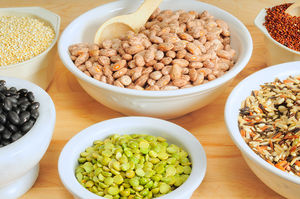Protein
| See Also | Clinical Nutrition |
|---|
Protein is a macronutrient composed of amino acids. Proteins are classified as either complete or non-complete proteins depending on whether the protein source contains the full complement of essential amino acids.
Contents
Protein Sources
Humans derive protein from a variety of sources, including meat and poultry, fish, eggs, dairy, legumes and beans, grains and nuts and seeds.
- Complete proteins include: beef, chicken, pork, eggs, seafood, yogurt, milk
- Incomplete proteins include: rice, beans, pasta, bread, soybeans,
- Although an adequate amount of protein can be consumed in a vegetarian diet, soy protein isolate is the only vegetarian source of protein that is considered a complete protein (meaning it contains adequate levels of all essential amino acids). Those on a vegetarian diet need to ensure that they practice protein combining in order to ensure a full complement of essential amino acids.
Food stuffs can be ranked on their protein content using the Protein Digestibility Corrected Amino Acid Score (PDCAAS) which is based on the amino acid requirement of humans. Egg white is the standard by which other foods are compared, and receives a PDCAAS score of 1. Below is the PDCAAS score for several commonly consumed foods:[1]
| Whey Protein | 1.00 |
| Whole Egg | 1.00 |
| Casein | 1.00 |
| Soy Protein Concentrate | 1.00 |
| Beef Protein | .92 |
| Soybean | .91 |
| Kidney bean | .68 |
| Whole Wheat | .54 |
| Wheat Gluten | .25 |
Uses
Proteins have a wide variety of physiological and anatomical roles, including but not limited to:
- structural component in tissues and cells
- based building block of DNA
- cell signalling and neurotransmission
- immune function
- enzymatic function
- precursors for hormones, cytokines
- energy sources
Deficiency Symptoms
Deficiency in dietary protein can occur as a result of inadequate protein intake, yet adequate calories or as a result of inadequate protein and caloric intake. In either case a deficiency can have drastic health effects including:
- Signs of Protein Deficiency:
Single amino acid deficiencies are rare. More commonly, amino acid deficiencies and associated signs and symptoms are a result of total protein deficiency.[2]
Moderate Deficiency
- slowed growth in children
- low levels of essential proteins in blood
Severe Deficiency
- apathy
- depigmentation of hair
- edema
- lethargy
- liver damage
- loss of muscle and fat
- skin lesions
- weakness
- Protein-Energy Malnutrition (PEM) is caused by an inadequate intake of protein sometimes coupled with increased catabolic stress and results in a pathological loss of muscle tissue. Weight reduction, thinning skin, apathy, edema, and muscle wasting are characteristic of the process. PEM can be life threatening if not identified and treated with increased caloric and protein supplemention.[3]
- Severe protein-energy malnutrition are rare in North America, but commonly occur in areas of famine. They include Kwashiorkor and Marasmus. Kwashiorkor refers to protein energy malnutrition where protein inadequacy is predominant, while marasmus refers to starvation where caloric inadequacy is predomoniant.
| Article | Sarcopenia, Nutritional Intervention for a Quiet Epidemic, IHP; November 2011 |
|---|
- Sarcopenia is a condition characterized by a loss of lean muscle tissue without an overall reduction in weight. Although a certain amount of sarcopenia is normal with advancing age, it has been linked to functional decline, osteoporosis, and impaired glucose tolerance. Sarcopenia is associated with increased oxidative stress, loss of growth hormone and loss of estrogen and androgen production and is caused by sub-optimal activity levels and inadequate protein intake.[3]
Intake Considerations
Excess protein is not stored in the body. Any protein that the body contains is involved in cell structure or in metabolic function. Hence, the amount of protein that is considered necessary is based on acquiring daily adequate levels of essential amino acids. Daily requirements of protein intake have been widely studied, but there remains some debate over protein adequacy. The standard for daily protein requirements in the general population is .6g/kg/day to .8g/kg/day [3]
- Activity Level. Protein requirements in active individuals and athletes may also exceed 0.8g/kg/day. The protein requirement of power sport athletes is between 1.4 and 1.8g/kg/day [4], while endurance athletes have a protein requirement between 1.1g/kg/day and 1/4g/kg/day [5].
- Health Status
Metabolism
Proteins are broken down in the stomach during digestion by protease which is an enzyme secreted by the pancreas. The protease enzyme breaks the protein into smaller polypeptides to provide amino acids.
The break-down products of protein are secreted by the kidneys.
References
- ↑ Protein Quality Evaluation. Report of the Joint FAO/WHO Consultation
- ↑ Griffith Winter H (2000) Vitamin, Herbs, Minerals & Supplements: The Complete Guide, MJF Books.
- ↑ 3.0 3.1 3.2 Prousky Jonathan (2008) Principles and Practices of Naturopathic Clinical Nutrition CCNM Press.
- ↑ Tarnopolsky et al. (Nov 1992) Evaulation of protein requirements for trained strength athletes. J Appl Physiol;73(5):1986-95.
- ↑ Lemon et al. (1995) Do athletes need more dietary protein and amino acids? Int J Sport Nutr;(5):39-61.

